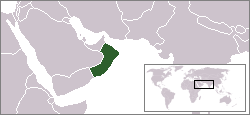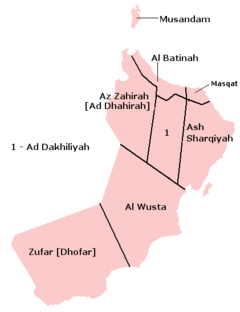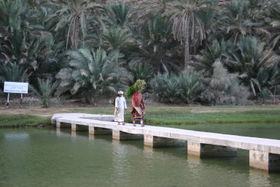Oman
2007 Schools Wikipedia Selection. Related subjects: Countries; Middle Eastern Countries
| سلطنة عُمان Salṭanat ʿUmān Sultanate of Oman |
|||||
|
|||||
| Motto: none | |||||
| Anthem: Nashid as-Salaam as-Sultani | |||||
| Capital (and largest city) |
Muscat |
||||
| Official languages | Arabic | ||||
|---|---|---|---|---|---|
| Government | Absolute monarchy | ||||
| - Sultan | Qaboos bin Said Al Said | ||||
| Independence | |||||
| - Portuguese expelled | 1650 | ||||
| Area | |||||
| - Total | 309,500 km² ( 70th) 119,498 sq mi |
||||
| - Water (%) | negligible | ||||
| Population | |||||
| - July 2005 estimate | 2,567,0001 ( 140th) | ||||
| - Density | 8.3/km² ( 211th) 21.5/sq mi |
||||
| GDP ( PPP) | 2005 estimate | ||||
| - Total | $40.923 billion ( 85th) | ||||
| - Per capita | $16,862 ( 41st) | ||||
| HDI (2004) | 0.810 (high) ( 56th) | ||||
| Currency | Rial ( OMR) |
||||
| Time zone | ( UTC+4) | ||||
| - Summer ( DST) | ( UTC+4) | ||||
| Internet TLD | .om | ||||
| Calling code | +968 | ||||
| 1 Population estimate includes 577,293 non-nationals. | |||||
The Sultanate of Oman ( Standard Arabic: سلطنة عُمان , Salṭanat ʿUmān IPA: [sʌltˤʌnʌt ʕʊmaːn]) is a country in Southwest Asia, on the southeast coast of the Arabian Peninsula. It borders the United Arab Emirates in the northwest, Saudi Arabia in the west, and Yemen in the southwest. The coast is formed by the Arabian Sea in the south and east, and the Gulf of Oman in the northeast. The country also has an exclave enclosed by the United Arab Emirates.
History
The Sultanate of Oman was once known by its Sumerian name Magan. Oman constituted one of the Satrapies of the Persian Empire. It was incorporated into that empire around 563 BC. This earlier empire was succeeded by the Sassanian Empire in the third century AD.
By the beginning of the first century of the Common Era, Arab tribes began to settle in Oman. In 632, the Sassanids lost power and Arab dominance in Oman was established.
In 751, Ibādī Muslims established an imāmate in Oman. Imāms exercised spiritual leadership over the country. The Ibādiyya are a branch of the Kharijites, the earliest Muslim sect which rejected both potential successors to Muħammad's leadership. This imāmate survived in Oman proper until the mid-twentieth century.
Oman has been a centre for traders for centuries. In 1508, the main port, Muscat, was captured by the Portuguese, who were expelled in 1650 . Oman was then taken by the Ottomans in 1659. The Ottomans were driven out in 1741, when the present line of sultans was formed by Aħmad ibn Saˤīd. However, Oman was occupied by Persia between 1743 and 1746.
In the early nineteenth century, Muscat and Oman grew to be a major power, having possessions in Baluchistan and Zanzibar, but these were gradually all lost. The final one, Gwadar, was sold to Pakistan in 1958. In 1891, Muscat and Oman became a British protectorate, which lasted until 1971.
During 1970, while Oman was still a protectorate, Sultān Saˤīd ibn Taymūr was ousted by his son, Sultān Qabūs ibn Saˤīd as-Saˤīd, who has reigned since then. Sultān Qabūs has since greatly improved the economic situation of the country, remaining in peace with all other countries in the Middle East. In 1996, the sultan issued a decree promulgating a new basic law that clarifies the royal succession, provides for a bicameral advisory council with some limited legislative powers and a prime minister and guarantees basic civil liberties for Omani citizens.
Military bases in Oman were used in 2001 by US forces involved in ground raids against Taliban forces in Afghanistan and Osama bin Laden. In 2003, the lower house of the advisory council was freely elected for the first time.
Politics
Chief of state and government is the hereditary sultān, Qabūs ibn Saˤīd as-Saˤīd, who appoints a cabinet to assist him. In the early 1990s, the sultan instituted an elected advisory council, the Majlis ash-Shura, though few Omanis were eligible to vote.
Universal suffrage for those over 21 was instituted on 4 October 2003. Over 190,000 people (74% of those registered) voted to elect the 83 seats. Two women were elected to seats.
The sultan functions as an absolute ruler.
Subdivisions
Oman is divided into three governorates ( muhafazah) and five regions ( mintaqat). These regions are subdivided into provinces ( wilayat). The governorates and regions are:
- Governorates
- Masqat (Muscat)
Musandam
Dhofar
Al-Buraymi (created October 2006)
- Regions
- Ad Dakhiliyah
Al Batinah
Al Wusta
Ash Sharqiyah
Az Zahirah ( Ad Dhahirah)
Geography
A vast desert plain covers most of central Oman, with mountain ranges along the north ( Jebel Akhdar) and southeast coast, where the country's main cities are also located: the capital city Muscat, Matrah and Sur in the north, and Salalah in the south. Oman's climate is hot and dry in the interior and humid along the coast. During past millennia Oman was covered by ocean. Fossilized shells exist in great numbers in areas of the desert up to 50 miles from the modern coastline.
Oman is considered to be one of the fifteen states that make up the so-called " Cradle of Humanity".
Exclaves and enclaves
The peninsula of Musandam (Musandem), which has a strategic location on the Strait of Hormuz, is separated from the rest of Oman by the United Arab Emirates and is thus an exclave.
Oman has one other exclave, this time inside UAE territory, known as Wadi-e-Madhah. It is located halfway between the Musandam Peninsula and the rest of Oman . The exclave is on the Dubai- Hatta road in the Emirate of Sharjah. Belonging to Musandam governorate, it covers approximately 75 square kilometres (29 sq mi). The boundary was settled in 1969. The north-east corner of Madha is closest to the Khorfakkan- Fujairah road, barely ten metres (30 ft) away. Within the exclave is an UAE enclave called Nahwa, belonging to the Emirate of Sharjah. It is about eight kilometres (five mi) on a dirt track west of the town of New Madha. It consists of about forty houses with its own clinic and telephone exchange .
Economy
The economy of Oman is dominated by its dependence on crude oil. A joint venture called IPC drilled a number of dry holes from 1956 onwards though the logistics of doing this were extremely difficult due to the lack of transport infrastructure.
A lack of success, combined with worsening logistical problems and a glut of oil on the world market, led most of the partners to withdraw from the venture in 1960. Only Royal Dutch/Shell and Partex opted to remain in Oman to continue the search for oil. They struck oil at Fahud in 1962 at a site just a few hundreds of metres from the last dry hole.
In June 1967, the Compagnie Française des Pétroles rejoined the partnership by taking over 10% of Partex's equity share, resulting in the following shareholding: Shell 85%, Compagnie Française des Pétroles 10% and Partex 5%. The company changed its name to Petroleum Development (Oman). Shortly followed by the first export of Omani oil on 27 July 1967.
On 1 January 1974 the Government of Oman acquired a 25% shareholding in the Petroleum Development (Oman); half a year later they increased it to 60%, backdated to the beginning of the year. As a result foreign shareholding in PD(O) was now made up of Royal Dutch/Shell (34%), Compagnie Française des Pétroles (now Total) (4%) and Partex (2%).
In a Royal Decree of 15 May 1980, the company was registered as a limited liability company (LLC) under the name Petroleum Development Oman.
Today Oman produces around 700,000 barrels (110,000 m³) of oil per day and there have been significant discoveries of natural gas and development of a liquefied natural gas terminal. Oil represents about 90% of Oman's exports.
The income generated was quickly deployed into building infrastructures of roads, schools, hospitals, water and electricity generating plants. All of this activity has made Oman a major success story for economic growth despite being the only oil-producing nation in the Middle East that is not a member of OPEC.
Oman's economic performance improved significantly in 2000 due largely to the upturn in oil prices. The government is moving ahead with privatization of its utilities, the development of a body of commercial law to facilitate foreign investment, and increased budgetary outlays. Oman continues to liberalise its markets and joined the World Trade Organization in November 2000. GDP growth improved in 2001 despite the global economic slowdown.
On 20 July 2006, the U.S. House of Representatives narrowly approved a US-Oman Free Trade Agreement. Regarding labor rights, the Government of Oman made numerous commitments to revise its labor laws to satisfy Congressional concerns. With respect to the assertions that the Agreement threatend the ability of the United States Government to protect its essential national security, the Congressional Research Service prepared several papers explaining that such was not the case. A recent State Department report criticized Oman for not taking enough action to reduce human trafficking but also acknowledged that the country "is making significant efforts to do so." The treaty will immediately end all duties on trade in industrial and consumer goods and give American farmers duty-free access to Oman's market for 87% of their products. Proponents of the deal claim that the pact will help liberalise the Omani market and open it to U.S. goods.
US President George W. Bush signed the bill into law on September 26 2006 .
Demographics
Oman is the world's easternmost Arabian country. The majority of Omanis are Arabs, although there are sizable Baloch and Swahili minorities. As in most other Arab countries, a large number of foreign workers live here, mostly from India and Pakistan. The official language is Arabic, but the minorities speak their own languages. A non-Arabic Semitic language Bathari is spoken in Dhofar.
Islam is the predominant religion, mostly Ibādiyya, with a Sunni population in Dhofar. Exact numbers are not certain.The largest religious minority are the Hindus which account for 13% of the population.





